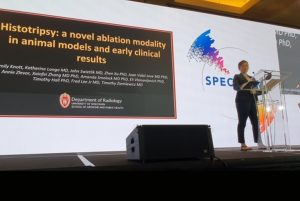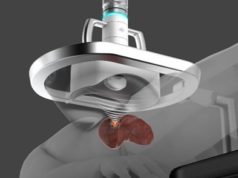
Investigators report a 100% technical success rate in creating their planned ablation volume and no major device-related complications in the first-in-human clinical cases using histotripsy, a novel ablation modality. Presented at Spectrum (18–22 January, Miami, USA) by Emily Knott, a research intern at the Department of Radiology, University of Wisconsin, Madison, USA, and currently applying to medical school, these early positive results offer “real potential” for the future of this therapy.
Histotripsy is a non-invasive, non-thermal ablation modality that uses focused ultrasound to create a cavitation bubble cloud which destroys the target tissue. This cavitation bubble cloud is precise at the histologic level: the resultant ablation zones are within millimetres of the prescribed location. “Coupled with a robotic arm, you can virtually prescribe any size and shape of ablation zone,” Knott described. The tissue within the ablation zone is completely necrotic.
“An interesting characteristic,” Knott observed, “is that because of these mechanical tissue destruction effects, there is architecture preservation within the ablation zone, including bile ducts and large vessels.
“The most interesting part of this technology, though,” she continued, “is the potential for an immune response.” Sharing early histotripsy studies conducted in mice at the University of Michigan, she described how investigators witnessed an abscopal response that is greater than radiation therapy and thermal ablation, as well as finding decreased metastases in the pulmonary area.
Describing the first ever human clinical cases, Knott told the Spectrum audience of the 100% technical success rate in creating the planned ablation volume, and of the lack of device-related complications.
Two patients demonstrated a potential abscopal response to therapy. Showing the MRI scans of one of these patients on her slides, Knott said: “The really exciting thing with this patient is that when we treated one tumour, a small percentage of this patient’s disease, the AFP [alpha-fetoprotein, a tumour marker] dropped disproportionately over eight weeks.”
In a second patient, with metastatic colorectal cancer, Knott recounts how the team treated a single tumour in the left lobe of the liver. One day post-treatment, imaging showed the tumour swelling slightly “with some inflammation”, but over time, it decreased in size to smaller than before ablation. “CEA [carcinoembryonic antigen, used as a diagnostic and prognostic tumour marker] also dropped disproportionately to the one tumour that we treated in the liver,” Knott said.
She concluded: “Histotripsy is a non-thermal and non-invasive ablation modality. It can safely create a planned ablation volume, and there is a potential immune stimulation in early pre-clinical results in mouse models, and in two of eight patients in an early clinical trial. This clinical trial will be more finalised and [eventually] published, and will also be presented at SIO [the annual meeting of the Society of Interventional Oncology; 31 January–3 February, New Orleans, USA].”













